An interview with André Schneider, CEO Geneva Airport. By Ross Falconer
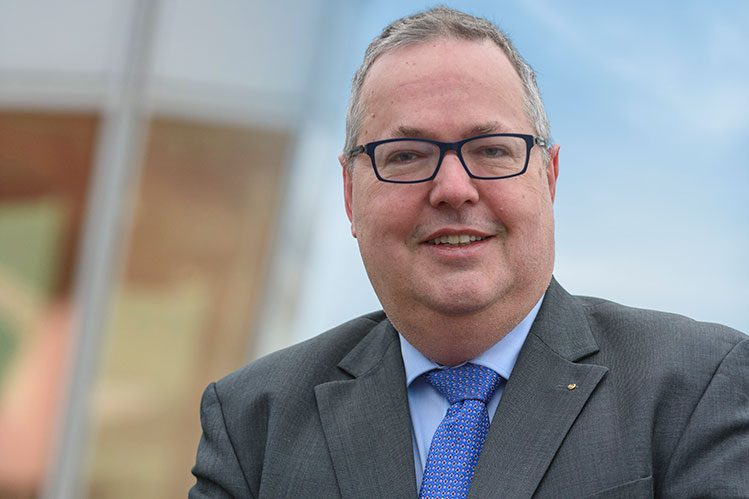
André Schneider, CEO Geneva Airport: “In early 2017 we experienced some major growing pains, with long queues. I must say that I was a little bit surprised, because we can usually make quite accurate growth forecasts. As a result, we spent the whole of 2017 upgrading as much as possible to be ready for this winter season, which has worked really nicely.”
Geneva calls itself “the world’s most international city”. It is a financial hub, a centre of diplomacy, and of course the gateway to the Alps.
The city is home to the European headquarters of the United Nations, the headquarters of the World Trade Organization, 750 pharmaceutical and biotechnology companies, 120 banking firms, the heart of the Swiss watch-making industry, and the EMEA headquarters of 130+ multinationals, including P&G, Nestlé, JTI and SITA.
This list is by no means exhaustive, but serves to highlight the importance of Geneva as a destination. Indeed, Geneva Airport’s traffic is growing – by 5% to 17.3 million in 2017 – and capacity constraints are a significant challenge for the airport and its new CEO.
André Schneider took the helm in September 2016, coming from a background outside the airports industry. Most recently, he was Vice President of Resources and Infrastructure at the Federal Polytechnic School of Lausanne, and before that spent 13 years in various roles at the World Economic Forum (most recently as Managing Director and Chief Operating Officer).
Our interview takes place early on a crisp winter’s morning. Schneider is energetic and enthuses about Switzerland winning its 12th Winter Olympics medal that very day (the country would ultimately win 15 and come 8th in the medal table). Only the day before, he had received gold medal winner Sarah Höfflin (slopestyle skiing) on her return to Geneva.
Beyond the panoramic views of the airfield from Schneider’s office, we can see the Swiss-French border which runs along the airport’s northern perimeter, the vista framed by the snow-topped peaks of the Alps in the distance.
In conversation, he is eloquent and frank about the challenges facing the airport. “One of the big surprises, being in the mobility business, is that you cannot fully control growth, but you have to manage its consequences,” says Schneider. “In early 2017 we experienced some major growing pains, with long queues. I must say that I was a little bit surprised, because we can usually make quite accurate growth forecasts. As a result, we spent the whole of 2017 upgrading as much as possible to be ready for this winter season, which has worked really nicely.”
Discussing the structural changes he has implemented on becoming CEO, Schneider explains that he very quickly reorganised the top management team, centring on two principal business units (Operations, and Commercial & Development) and five strategic pillars (platform operability, customer satisfaction, economic sustainability, management of human resources and skills, and commitment to responsible values).
“The reason I did this is that I believe airports need good transversal management, covering commercial, operational, sustainability, and IT aspects. When I came here the central leadership was, for me, too limited,” he says. “HR is also a big challenge for us. Switzerland is a small country and the airport business is still very much nationally regulated, so if, for example, I want to hire a new COO familiar with Swiss regulations, there is not a big pool of candidates.”
Meanwhile, another potential challenge looms on the horizon. Following a similar referendum in 2014, and against the backdrop of the much higher profile Brexit negotiations, in January Switzerland moved closer to a referendum on the free movement of EU citizens to Switzerland. This agreement was enshrined in a package of bilateral treaties signed in 1999 and significantly, if one bilateral agreement falls, so too do all of the others, including on aviation.
“Absolutely, there are very comparable issues to the UK,” says Schneider. “The Air Transport Agreement gives us automatic access to all destinations in Europe – if that would fall, Switzerland would have to renegotiate flight rights with each individual country. Even if I don’t think negotiating those is a major problem, it will take time. Hence, we are also concerned about the speed non-EU countries can renegotiate flight rights with the UK, because for Geneva, London is our prime destination with 2.4 million passengers. So, we want naturally to avoid losing those flight rights, even temporarily.”
New East Wing for intercontinental services
The airport estimates demand will reach 25 million passengers by 2030, driven by the economic, touristic and diplomatic growth of the dynamic Lake Geneva region. It is investing in infrastructure to accommodate this, with a new CHF480 million (€415m) East Wing currently under construction and scheduled to open by the end of 2020.
“A great outcome of our restructuring is that this year we have been able to revisit our strategic planning internally, rather than outsourcing it, with input from all business and other units,” Schneider comments. “The next major project will be the replacement of our main terminal which originally opened in 1969. It has been extended year-by-year, but we’re reaching the limit of its expansion now. Replacement will come somewhere between 2022 and 2029, setting the basis for our next 20-30 years of development. Switzerland has a very defined planning process, which we are currently completing with the Federal Government.”
The new East Wing will mainly be dedicated to long-haul traffic, in line with the airport’s strategic objective to expand intercontinental services. Most recently, Ethiopian Airlines announced it will launch services, three times weekly, between Addis Ababa and Geneva on 3 June. Schneider explains that the route was hotly anticipated in the diplomatic world, with Addis Ababa home to several intergovernmental organisations including the African Union and the UN’s Economic Commission for Africa.
But, overall, Geneva’s traffic is predominantly European point-to-point, with only around 5% of passengers connecting. “We want to increase transfer traffic slightly, because we know that on certain potential intercontinental routes, we are just at the edge of their attractiveness for airlines,” Schneider explains. “Given that we have an excellent European network, we believe that by increasing overall connecting flights by 3-5% we would generate enough passengers for some new intercontinental routes.”
The airport is also studying models such as GatwickConnects, which assists travellers self-connecting between different airlines.
SWISS has a 15% market share at Geneva, and Star Alliance carriers overall a 28% share. Low-cost carrier traffic, dominated by easyJet, accounts for 45% of Geneva’s total. Schneider is happy with the current airline mix. “easyJet brings us good connectivity in Europe. We still have good legacy carriers, such as SWISS and Lufthansa, which are developing well. We also have developments with Air France-KLM, British Airways, and TAP, so I think it’s the right mix, because many of those legacy carriers also provide good connections to their hubs, so even if it’s going through another major airport, they offer our customers good connectivity.”
Geneva has a proactive route development strategy. In addition to a marketing package, it offers up to an 80% reduction on landing fees for new routes. It has also launched an incentive scheme rewarding airlines for the traffic growth they generate; this involves a refund on the passenger service charge of between 3.5% and 20%.
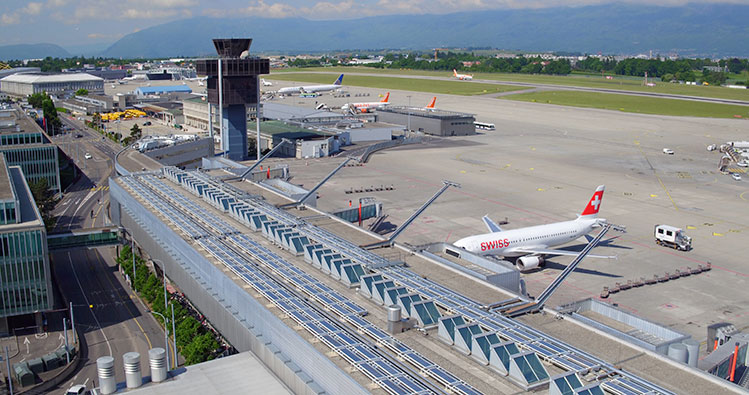
SWISS has a 15% market share at Geneva, and Star Alliance carriers overall a 28% share. Low-cost carrier traffic, dominated by easyJet, accounts for 45% of Geneva’s total. Schneider is happy with the current airline mix. “easyJet brings us good connectivity in Europe. We still have good legacy carriers, such as SWISS and Lufthansa, which are developing well.”
Addressing sustainability
While expanding, sustainability is high on the agenda. Geneva Airport recently achieved Level 3+ Neutrality of ACI’s Airport Carbon Accreditation, reducing the net emissions under its control to zero. “Sustainability is one of our key strategic endeavours,” says Schneider. “For example, all new buildings are positive in energy – that means they produce more energy than they consume. We are also working on a new project which will introduce 1% of bio-kerosene to all kerosene loaded at Geneva – that will start in December this year. And we are working on increasing the presence of hybrid or electric vehicles at the airport – we will reach 40% by 2020.”
Other key goals include even better waste management. The recycling rate is 42% across all facilities, and 49% in the main terminal. Meanwhile, a sorting system specifically for waste generated by aircraft was implemented in 2015 through a pilot project conducted with easyJet. The experiment was successful and was expanded in September 2016 to include all airlines.
A new mobility plan is being developed that favours the use of public transport. “We have organised our own bus lines to pick-up our own staff, and this is done with our partners here – so we are supporting them in this joint venture. The airport has to show the direction and support all parties here to follow up,” Schneider adds. “38% of passengers currently travel to the airport via public transport, and we aim to raise that. For example, today we offer a free public transport ticket to everyone arriving in Geneva. The airport rail station connects you to the city centre in just 7 minutes.”
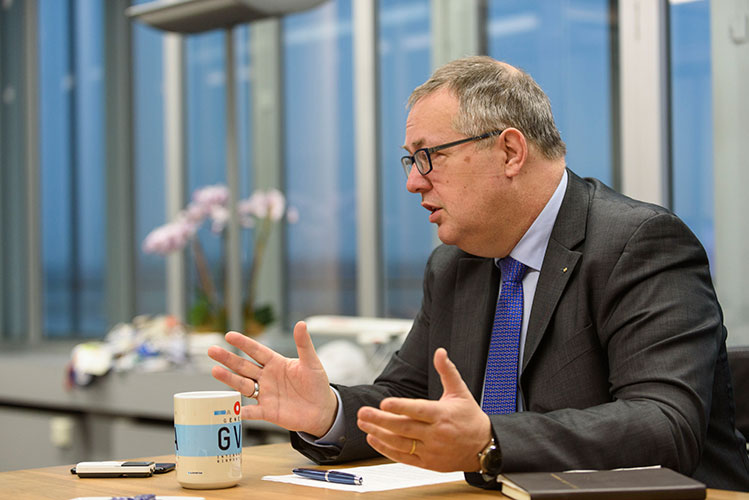
On becoming CEO, Schneider very quickly reorganised the top management team, centring on two principal business units and five strategic pillars. “The reason I did this is that I believe airports need good transversal management, covering commercial, operational, sustainability, and IT aspects. When I came here the central leadership was, for me, too limited.”
Blockchain, chatbots, and start-ups
Geneva Airport is progressive in its application of new and emerging technologies. It recently took part in a data sharing project, known as FlightChain, involving the use of blockchain technology along with SITA Lab, British Airways, Heathrow and Miami International Airport, and has been a trend-setter when it comes to trialling passenger-facing robots (“Robbi” in 2013 and “Leo” in 2016).
Indeed, embracing new technologies is a subject close to Schneider’s heart. A sci-fi enthusiast, interspersed among the model aircraft that typically adorn an airport CEO’s office is a collection of memorabilia from Star Wars, Star Trek and Doctor Who.
The FlightChain project was Geneva Airport’s first step into blockchain. “It’s a good initiative to put people together in the airport world. That’s definitely something that we need to do more, and it’s the best way to deliver more innovative use cases,” says Schneider. “Blockchain is obviously very hot at the moment and in Geneva there are several initiatives to develop blockchain projects; there is real belief that it’s going to bring value to the market.”
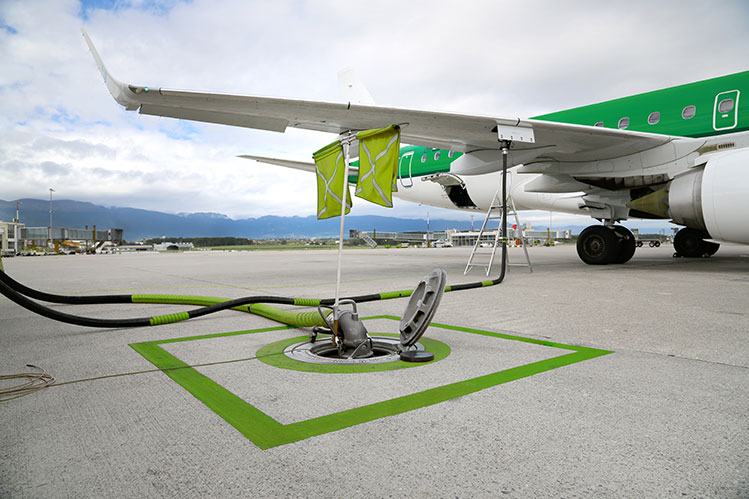
Geneva Airport is working on a new project which will introduce 1% of bio-kerosene to all kerosene loaded at Geneva – that will start in December this year. It is also working on increasing the presence of hybrid or electric vehicles at the airport – it will reach 40% by 2020.
Meanwhile, an artificial intelligence chatbot, which is currently in beta, will soon be launched on the Facebook Messenger platform. The chatbot will help to bring the right information to passengers when they need it and can help to “bridge the gap between the airline experience and the airport experience” in the future.
Another project that Geneva Airport’s innovation department is focusing on is called “GVA Welcome”. The idea behind this is to “create a better experience between the people who arrive at the airport and the people who are waiting for them at the airport”. Having already created a minimum viable product (MVP) in late-2017, they are now working on integrating it with the Geneva Airport app. The app itself – GVApp – is at the heart of the airport’s digital offer and now has about 200,000 users, who use it to access free Wi-Fi, retail and food & beverage promotions, public transport information, and interactive geolocation maps.
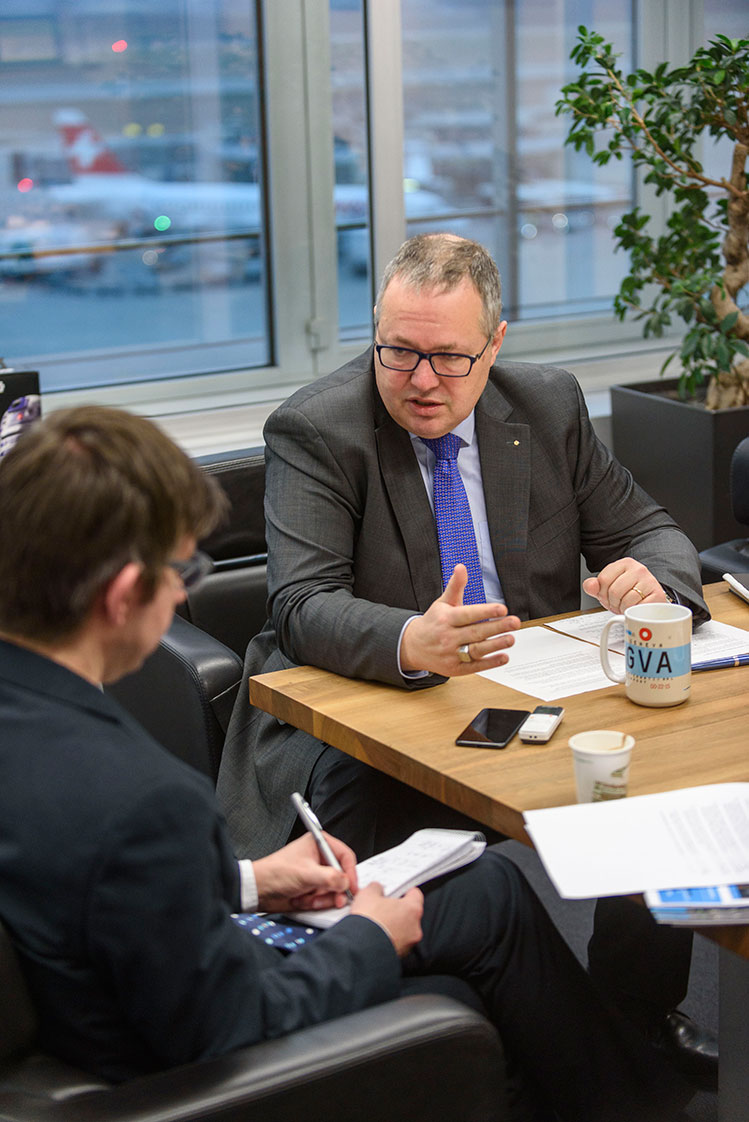
André Schneider, CEO Geneva Airport: “One of my real interests in professional life is the desire to achieve excellent strategic planning, working to understand future trends, and defining the main drivers that will have a big impact on our business moving forward.”
The airport also has a keen interest in the start-up scene and is identifying start-ups that can potentially support its innovation efforts. In fact, following last year’s Recoding Aviation hackathon, Geneva Airport – alongside Copenhagen, Swedavia and Amsterdam Schiphol – has been incubating two start-ups.
This progressive approach is similarly being applied to commercial & retail activities, which currently account for almost 50% of overall revenues. Schneider acknowledges the challenge of competing with online shopping and explains that the airport is looking ahead to define the creative and experiential retail and F&B offers it believes will be most effective in 10-15 years.
“I must say the fun part here is that there is almost nothing that will not change fundamentally over the next 10 years, and we need to start planning for those changes today. This brings me back to the very beginning of our interview – one of my real interests in professional life is the desire to achieve excellent strategic planning, working to understand future trends, and defining the main drivers that will have a big impact on our business moving forward.”
Geneva Airport factbox
2017: 17.3 million passengers
2017 passenger traffic growth: 5%
2018 passenger traffic growth (Jan-Feb): 4%
Key airline customers: easyJet, SWISS, British Airways, Air France, Lufthansa
Number of routes: 142
Top 5 destinations: London, Paris, Amsterdam, Barcelona, Porto







